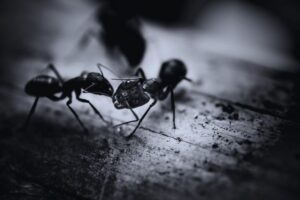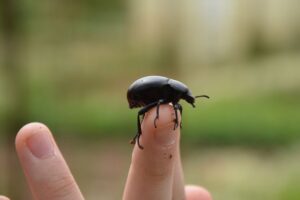Spiders come in different shapes, sizes, and colors. If you’ve ever seen a brown spider with a white butt, you might be wondering what it is or if it is venomous.
There are two types of spiders usually described as having white butts. One is the brown recluse spider, which has a light-colored abdomen. The other one is the female wolf spider, which carries an egg sac that resembles a white butt. Both are venomous, but only one of them can be fatal.
Read on to learn more about spiders with white butts, their physical appearance, behavior, and more.
Spider With White Butt – What Is It?
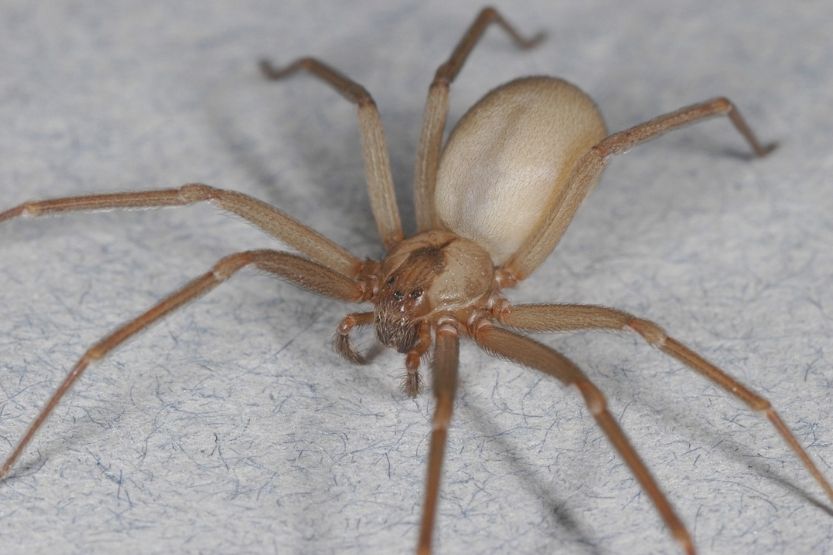
Two types of spiders are usually described as having white butts. One is the female wolf spider, which carries an egg sac that resembles a white butt. The other is the brown recluse spider, which has a light-colored abdomen. Both are venomous, but only one of them can be fatal.
Brown Recluse Spider – A Spider With White Butt
An oft-reported type of spider with a white butt is Loxosceles reclusa. Also known as the brown recluse, it belongs to the arachnid family Sicariidae. It is the most widespread species of brown spiders. But you can only find it in the south and central parts of the United States. Also, the brown recluse spider is famous for its distinctive appearance and venomous bite.
Let’s talk about the physical appearance of the brown recluse spider according to the following categories:
- Size
- Color
- Markings
- Uniqueness
1. Size
The brown recluse spider typically measures between 6 and 20 mm (0.24 and 0.79 inches). But it can grow larger. As reported by the Ohio State University, it is around 3/8 inches in length and about 3/16 inches in width. This means that it is about 1 cm long and 1/2 cm wide.
The male brown recluse is slightly smaller than the female but possesses longer legs. The brown recluse’s legs are covered in fine hairs but have no spines, and the scientific name Loxosceles, or “slanted legs,” refers to their slanting position when at rest.
2. Color
While ordinarily light to medium brown, the recluse spider’s color ranges from whitish to dark brown or blackish-gray. The abdomen is covered in fine hairs that give it a velvety appearance. The cephalothorax (head and thorax) and the abdomen are not always the same color. So a lighter-colored or white butt can be easily noticeable.
3. Markings
Brown recluse spiders usually have violin-shaped markings on the dorsal side of the cephalothorax. This is why they are also called a brown fiddler, fiddle back, or violin spiders.
The markings vary in intensity depending on the spider’s age, with those on more mature spiders being much darker. Note that other spiders also have similar violin markings. These include cellar spiders and pirate spiders.
4. Eyes
A distinguishing characteristic unique to the brown recluse is its six equal-sized eyes. This is in contrast to the eight eyes that most spiders usually have. Also, while other spiders’ eyes are arranged in rows of four, the eyes of the recluse spider are arranged in three pairs (dyads). They form a semi-circle around the front of its cephalothorax.
Brown Recluse Spider Distribution
The range of the brown recluse is documented to roughly lie south of a line going from southeastern Nebraska to southern Iowa, Illinois, and Indiana to southwestern Ohio. In southern states, brown recluse spiders originate from central Texas through western Georgia and north to Kentucky.
Brown Recluse Spiders in California
Contrary to rumors, brown recluse spiders have not been established in California or anywhere outside their native range. Other Loxosceles species are similar to the brown recluse native to the southwestern United States, including California.
But interactions with humans in the region are rare due to their native ranges lying outside dense human populations.
Only one out of 581 brown recluse sightings in California was accurate nationwide. The reports mostly misidentified a spider of the genus Titiotus, whose bite is considered harmless. Nonetheless, physicians in the Western United States tend to diagnose “brown recluse bites,” which led to the misconception that those spiders inhabit the region.
Other States Where the Brown Recluse Spider Can Be Found
You can also find the brown recluse spider in the following states:
- Kansas
- Oklahoma
- Louisiana
- Arkansas
- Missouri
- Mississippi
- Tennessee
- Alabama
- Parts of Georgia
It may be possible to encounter a brown recluse outside the covered areas. But it is considered highly unlikely.
Brown Recluse Spider Habitat and Behavior

Let’s discuss the following about this spider’s habitat and behavior:
Reclusive Nature of Brown Recluse Spiders
The brown recluse spider is so named because of its reclusive nature. It usually takes refuge in dark and secluded areas. At home, they tend to make their home in dry and undisturbed places, including:
- Closets
- Sheds
- Porches
- Garages
- Cellars
- Woodpiles
They seem to favor cardboard particularly.
Maybe because of its similarity to rotting tree bark, which they inhabit in nature. You can identify it as unique – one of the only brown spiders with a white butt.
Male and Female Brown Recluse Spiders
Brown recluse spiders are nocturnal. Unlike most spiders, they leave their lair at night to hunt. When hunting, male brown recluses move around more than females, which usually remain closer to their webs.
A female spider only needs to mate once to lay eggs throughout her lifetime. Producing several egg sacs from May to July can have 150 or more spiderlings within a year. It only takes a single female brown recluse to start an infestation.
How Brown Recluse Spiders Travel Around
Brown recluses can travel around by hitchhiking onto furniture boxes or any item taken from an infested structure. With a long lifespan of about one to two years, they can endure up to six months in scorching and dry conditions without food.
Brown Recluse Spider Bite and Treatment
Let’s now talk about the following related to bite and treatment:
Brown Recluse Spider’s Bite Symptoms
While brown recluse spiders are rarely aggressive and try to avoid humans, they will bite if threatened. A brown recluse bite’s most common systemic symptoms include the following:
- Itching
- Rashes
- Fever
- Chills
- Sweating
- Nausea
- Vomiting
- Joint and muscle pain
On rare occasions, they can result In hemolysis, blood clots throughout the body, low platelet levels, organ damage, or even death. Fatalities are primarily children below the age of seven or people with a weak immune system.
Reaction to Brown Recluse Bites
Reaction to brown recluse bites differs according to how much venom was injected and the bite victim’s sensitivity levels. Some may have an immediate response, others a delayed reaction, and others may not react.
Small Red Mark
Many bites leave behind a small red mark that quickly heals. But most leave no scars at all and may heal even without medical attention.
Small White Blister
On the other hand, highly-sensitive individuals may experience a small white blister soon after being bitten. This may eventually lead to the following:
- Tissue damage,
- Infection, and
- Severe scarring that may take eight weeks or more to recover from.
What to Do When Bitten by a Brown Recluse Spider?
1. Call 911 or Poison Control
If bitten by a brown recluse spider, call 911 or poison control, or get to an emergency room as soon as possible.
2. Wash the Bitten Area with Soap and Water
For first aid, wash the bitten area with soap and water. Then, apply an ice pack or wrap ice in a washcloth on the bite wound for 10 minutes. Remove the ice for another 10 minutes, and then repeat the procedure.
3. Bring the Spider
If you can easily capture the spider, keep it in a clear, tightly-closed container. Bring it with you to the emergency room to be identified.
Again, spider with white butt – what is it? Spiders with white butts can either be a brown recluse spider with a light-colored abdomen or a female wolf spider, which carries a white egg sac. You have to be careful since both are venomous.
Wolf Spider – A Spider With White Butt
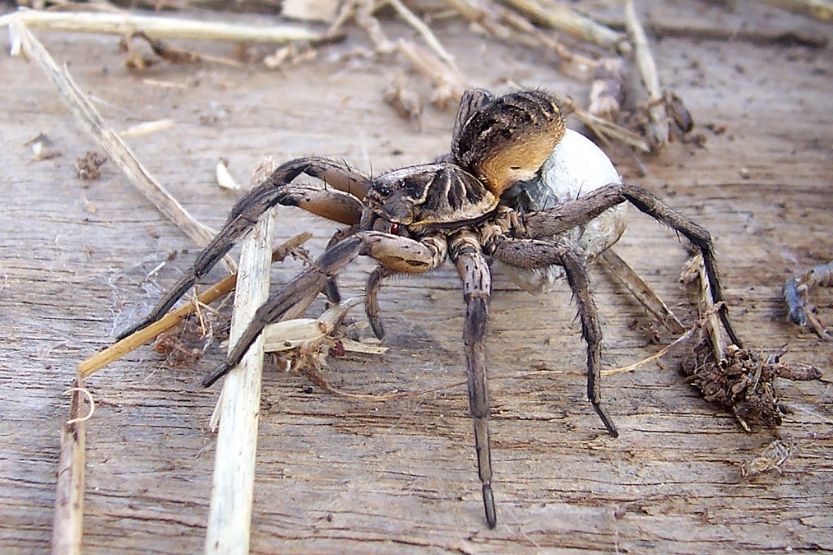
The Lycosidae family, wolf spiders, consists of more than 100 genera and around 2,300 species, 200 found in the United States. They are distributed worldwide, spreading as far as Africa, Asia, Australia, and Europe.
These spiders don’t have white butts. But their females can sometimes appear to have huge ones because of the large egg sacs they carry around with them.
Wolf Spider Physical Appearance
Let’s talk about the physical appearance of the wolf spider according to the following categories:
- Size
- Colors and Markings
- Eyes
1. Size
The body size of the various wolf spider genera ranges from less than 10 to 35 mm (0.4-1.38 in), with the males usually smaller than the females. The largest species is Hogna carolinensis, or the Carolina wolf spider, which can grow to a length of more than 2.5 cm (1 in).
2. Colors and Markings
Wolf spiders are typically colored brown, black, gray, or tan, with dark, usually striped, markings. Their color serves as an effective camouflage to help them capture prey and hide them from predators.
3. Eyes
Wolf spiders have eight eyes that are arranged in three rows. The bottom row consists of four eyes. Whereas the middle row consists of two large eyes, the top row comprises two medium-sized eyes.
Most arachnids are normally blind or have poor eyesight. But wolf spiders possess excellent night vision that gives them the ability to hunt in the dark. However, you can easily detect them due to the light reflected on their eyes.
So if you see a spider with a white butt in your home, it could be a wolf spider with a large egg sac.
Wolf Spider Habitat and Behavior
In terms of the wolf spider’s habitat and behavior, let’s talk about the following:
Wide Distribution
Wolf spiders have wide distribution due to their spiderlings dispersing aerially. They are prevalent in meadows and grasslands. But they are also found in a wide range of coastal and inland habitats. These include the following:
- Deserts
- Mountains
- Rainforests
- Even suburban gardens and homes
Some wolf spider species hunt in a set territory and feed in a specific place, while others nomadically wander with no permanent home. Others hide in leaf litter and vegetation. And some build burrows or dig tunnels, and others are often found in sheds and other artificial locations.
How Wolf Spiders Stalk Their Prey
Often mistaken for tarantulas, wolf spiders are mostly nocturnal and solitary, stalking their prey in the night alone. They make use of their sharp eyesight, camouflage coloring, quick reflexes, and heightened sensitivity to vibrations to catch prey and avoid predators.
They prey primarily on ground-dwelling insects and other spiders; wolf spiders are preyed on by birds, lizards, and certain rodents.
While some species of wolf spiders will chase and grab their prey, others will wait for the prey to pass by and ambush it. Wolf spiders will usually jump on their prey and hold it between their legs. They roll over on their backs, then trap it with their limbs before they bite it.
Wolf Spider Bite
Although wolf spiders will bite if provoked, their venom is not harmful to humans. Those bitten may experience the following:
- Itching
- Redness
- Swelling
- Mild pain
But otherwise, there are no reports about severe medical.
Wolf Spider Mating
Many wolf spider species engage in a rather complex mating behavior.
Male Wolf Spider Mating Behavior
For instance, males of the genus Schizocosa display courtship in two ways. One is through stridulation or the act of rubbing together certain body parts to produce sound. The other one is by drumming their forelegs on the ground. Some may use visual cues, such as waving their two front legs in the air in front of a female.
Female Wolf Spider Mating Behavior
Female wolf spiders generally produce several dozen or more eggs after mating. They have a unique way of carrying their eggs. These spiders wrap their eggs in a round silken egg sac to attach to their spinnerets at the abdomen’s end. This is what gives them the appearance of having big white butts.
Wolf Spider Mothers
Wolf spider mothers behave aggressively while carrying their egg sacs. Plus, they search for their eggs when separated from them.
These spiders are also still capable of hunting despite carrying their sacs. Once the spiderlings hatch, they will climb on the mother’s back to carry them for several days until they are strong enough to disperse.
How Wolf Spiders Look for a Mate
Because of their nomadic nature, population density, and the male-to-female sex ratio, there is selective pressure on wolf spiders when looking for a mate.
A female wolf spider that has already mated is more likely to eat the next male spider that tries to mate with it than that which has not mated yet. A male wolf spider already mated has a higher probability of mating successfully again. But a female that has already mated has a lower probability of mating once more.
While a male wolf spider usually lives for a year or less, a female can live for several years.
Conclusion – Spider with White Butt
Two types of spiders are usually described as having white butts. One is the female wolf spider, which carries an egg sac that resembles a white butt. The other is the brown recluse spider, which has a light-colored abdomen. Both are venomous, but only one of them can be fatal.
The brown recluse is a spider with a white butt. It is their occasionally whitish light-colored abdomen that makes them appear so. Meanwhile, the white butt of the female wolf spider is a sac wherein they carry their eggs.
If a brown recluse spider ever bites you, seek medical help immediately. And while the bite of a wolf spider isn’t deadly, you should try not to provoke one.

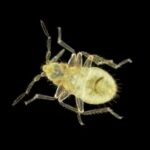
![White Salt-Like Grains in Bed [What Are They?] White Salt-Like Grains in Bed](https://homecarezen.com/wp-content/uploads/2021/12/white-salt-like-grains-in-bed-150x150.jpg)


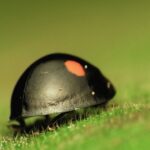

![Read more about the article White Salt-Like Grains in Bed [What Are They?]](https://homecarezen.com/wp-content/uploads/2021/12/white-salt-like-grains-in-bed-300x200.jpg)
